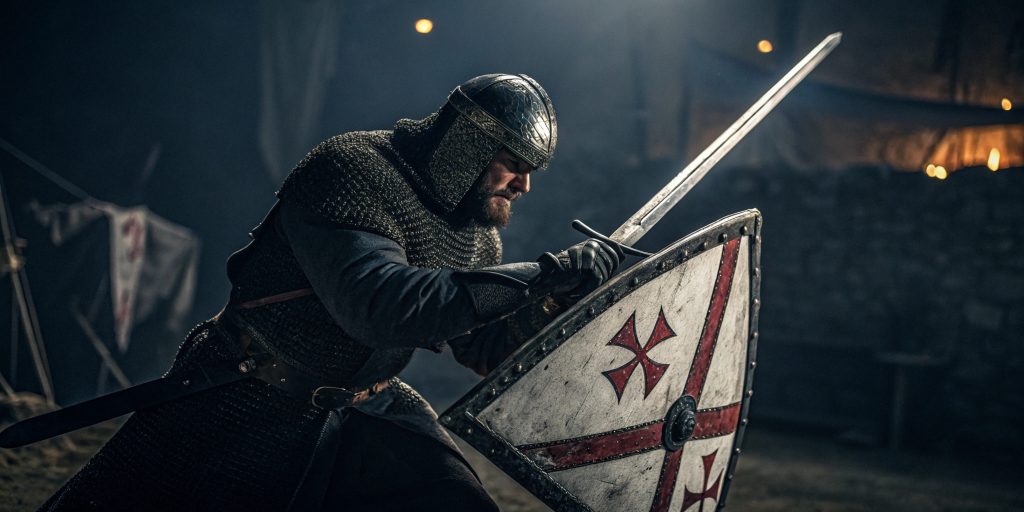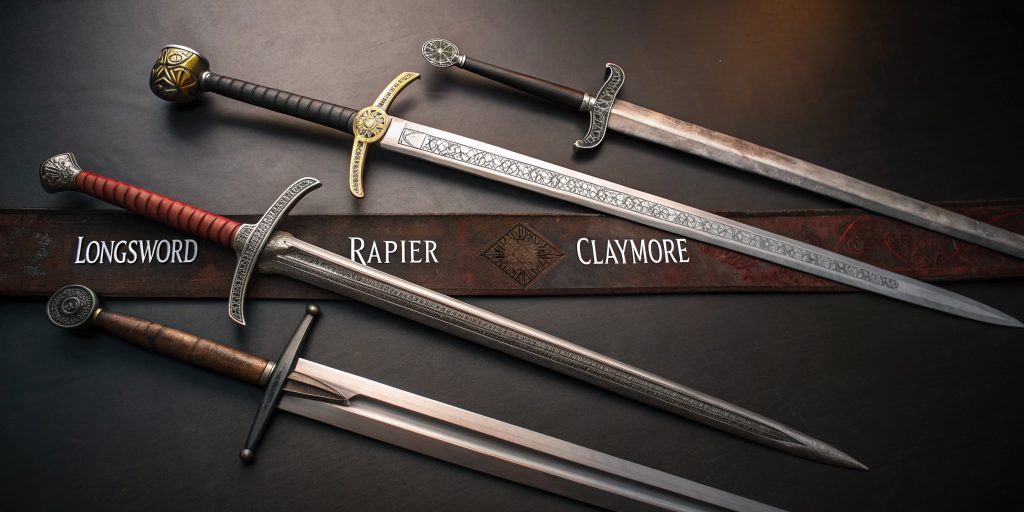The Templar Knights were known for their bravery and skill in battle. Their use of many types of medieval swords was key to their success in the Middle Ages.
Arming swords and great swords were especially important. They helped the Templars fight well, and knowing about these swords shows their effectiveness in battle.
It also tells us about medieval history and culture, particularly through the evolution of the curved sword. Swords were not just for fighting. They showed status and power. Let’s explore the Templar Knights’ legacy through their famous swords.
Introduction to the Templar Knights and Their Swords
The Templar Knights were a powerful group in the early 12th century. They protected pilgrims going to the Holy Land, making them key players in the Crusades.
They were known for their bravery and commitment to both faith and fighting. Their swords were more than just weapons. They showed the Templars’ dedication to their mission.
The Templars’ swords were famous for their unique designs, which showed their battle skills and values. Today, these swords remind us of the mix of war and faith in the Middle Ages.
The Importance of Swords in the Medieval Era
Swords became vital in the medieval era in war and as status symbols. They were more than just tools; they showed a knight’s or lord’s honor. Each sword was a work of art, made for different fighting needs.
Military swords changed with new battle tactics. They were symbols of power and strength, and having a sword showed one’s authority and respect in society.
Different swords were made for various uses, from fighting to ceremonies. Each type had its role, showing swords’ value in society. Their beauty made them precious beyond their use in battle.
Understanding Different Medieval Sword Types
Medieval swordsmanship gives us a peek into ancient battles. It shows us the different types of medieval swords used back then. Arming swords and longswords are two main types. Each type shows how warriors fought and what worked best in battle, including the use of the longsword and rapier.
Arming Swords: A Core Weapon
Arming swords, such as knightly swords, were vital for knights and soldiers during the medieval period. They have straight, double-edged blades and are 30 to 40 inches long, making them versatile in fights.
They can be used with one hand, allowing warriors to perform attacks and defenses. Their flexibility made them popular in many battles.
Longswords: Versatility in Combat
Longswords have long blades and need two hands to hold. They are 35 to 55 inches long. This design gives warriors more reach and power.
Knights liked longswords for fighting from far away or close. They can do many moves, like thrusting or sweeping. This made longswords very important in battles.
Arming Swords: Characteristics and Usage
Arming swords were key in medieval battles. They were known for their special features and design. Knights loved them for their mix of speed and strength.
Blade Length and Design
Arming swords had blades that were 28 to 32 inches long. This length made them great for many fights. Their straight, double-edged blades were good for both cutting and thrusting.
Some had fuller grooves, enhancing the performance of the broadsword. These made the sword lighter but still strong.
Combat Techniques with Arming Swords
Knights used arming swords in many ways. They were good for both close fights and big battles. Depending on the situation, knights could stab or swing.
Their skill in using these swords made them very effective. This was because of the sword’s design and the knight’s training.
Longswords: The Knightly Weapon of Choice
Longswords became the top choice for knights in medieval times. They changed a lot, showing how design and fighting methods evolved. This change helped knights in different battles, showing how swords and armor tactics grew together.

Evolution from Early to Late Medieval Longswords
The longsword changed from one-handed to two-handed swords over time. Early ones had straight, double-edged blades for thrusting and cutting. As battles changed, so did the sword’s look:
- Blades got longer for more reach, particularly in the case of the rapier.
- Blades widened for more substantial cuts, a feature often seen in the broadsword.
- Hilt designs improved for better grip and power.
Knights used these swords in new ways, mixing attack and defense. They changed their fighting styles to fit the changing battlefields.
Two-Handed Techniques and Styles
Using both hands became key for longsword fighters, especially when wielding a hand-and-a-half sword. This let knights use their swords with more power and accuracy. They used:
- Intense downward strikes to break armor.
- Thrusts to hit weak spots in opponents.
- Smart defensive moves for counter-attacks.
These moves showed a knight’s skill and the growing complexity of sword fighting, particularly with the hand-and-a-half sword. It was all about mixing offense with smart defense.
The Great Sword: A Symbol of Power
The great sword, often a broadsword, shows the power and might of the medieval era. It’s a large two-handed sword of considerable size, which boosts its fighting power and visually indicates its power.
These swords have long blades, 40 to 60 inches long, which allows them to reach far and hit hard.
The great sword is both functional and a symbol of honor. Its design helps in fights. It makes its users look intense and scary on the battlefield.
Historical leaders and knights used these swords. They show the strength and courage needed by leaders. Today, the great sword still shows what it means to be strong and noble.
Other Notable Sword Types Used by Templar Knights
Templar Knights used many swords for different fights. Each sword was key to their success. The bastard sword, short sword, and dagger were significant.
The Bastard Sword: A Hybrid Weapon
The bastard sword was great for many fights. Knights could use it with one or two hands. This made it perfect for changing tactics quickly.
Its length was good for open fights and tight spots. This made it a top choice for many.
The Short Sword: Close Quarters Combat
The short sword was vital for quick battles. Its short blade was perfect for fast strikes and defense. Knights could move quickly around enemies with it.
This helped them hit their targets in tight spaces. It was a vital tool for Templar knights.
The Dagger: A Complementary Blade
The dagger was a key part of Templar gear. It was used for fighting, surprise attacks, and hiding.
Like a small sword in the 16th century, the dagger helped knights keep fighting in tight spots. It showed how important being flexible was for Templar knights.
Medieval Sword Types: A Comprehensive Overview
The 15th-century sword world is vast, with many types of swords, each with special features and uses. This overview looks at medieval swords, focusing on their size, use, and design.
Medieval swords fall into three main groups:
- Single-edged swords: Great for slashing, these blades are made for cutting. They give warriors good control in battle.
- Double-edged swords: These versatile swords are good for cutting and thrusting and are used in many battle situations.
- Thrusting swords: Made for stabbing, these swords have sharp points. They are perfect for piercing.
Knowing about these sword types helps us better understand medieval warfare. It shows how different swords were used in battles and highlights the importance of choosing the proper sword for the job.
This look into medieval English sword types shows how warfare evolved. As battles changed, so did the swords. The variety in sword design, including the hand-and-a-half sword and curved sword, shows their function and the history of swordsmanship.
Specific Features of Templar Swords
Templar swords are known for their mix of function and beauty. They have special pommel designs and different hilt types. Each part was made with care, showing the skill of the sword makers.

Knowing about these features helps us see how Templar knights used their swords. It shows how they fought in battles, reflecting the tactics of the medieval period.
Pommel and Hilt Varieties
The pommel helped balance the sword, making it easier to control. It came in shapes like round or cross, making each sword unique.
Hilts were simple or fancy, showing the owner’s status and style. The work on these hilts ensured the sword felt good in your hand. This was key for fighting well.
Blade Types: Straight vs. Curved
There’s a big difference between straight and curved blades. Straight blades were great for thrusting, while curved blades, like the rapier’s, were better for slashing. The choice depended on the fight and the knight’s style.
This shows the importance of making swords that fit the knight’s needs and highlights the sword makers’ skill.
Sword Tactics and Techniques of the Templar Knights
The Templar Knights were known for their skill in medieval battles. They used advanced sword tactics that set them apart. Their fighting style was not just about strength. It also included smart strategies and understanding combat.
They often fought in lines, which helped them attack and defend well. This way, their swords could attack from different sides, making them hard to beat.
The Templar Knights were also great at both attacking and defending. They would block an enemy’s strike and then quickly attack back. This showed their skill in sword fighting, helping them stay calm in battle using a knightly sword.
- The use of feints creates openings for a decisive strike.
- Employing thrusts as well as slashes to keep opponents guessing.
- Executing quick, targeted strikes aimed at vulnerable points in armor.
The Templar Knights’ fighting style was shaped by their chivalric code, which valued honor and skill. Knights were trained in physical and mental strategies, making them strong opponents for centuries.
The Role of Swords in Templar Warfare
Swords were vital for the Templar Knights in battles. In medieval times, swords were the primary weapon. The Templars trained hard to master these swords, becoming skilled in sword fighting.
Combat Strategies and Sword-Fighting Styles
Templar Knights devised smart battle plans. They used swords for both attacking and defending. Their training made them fast and robust in close fights.
They learned different sword styles for different battles. These styles included:
- Thrusting Techniques: Aimed at penetrating enemy defenses.
- Slice and Cut: Focusing on quick, decisive blows to incapacitate opponents.
- Defensive Posturing: Utilizing the sword to block and counter enemy strikes.
These styles showed how swords were versatile. They also showed the Templars’ deep battle tactics.
Influence of Military Training on Swordsmanship
Templar Knights got tough training. It made them great with swords. Their training included:
- Physical Conditioning: Building strength and endurance for prolonged combat.
- Drills and Sparring: Practicing techniques and strategies against peers.
- Situational Awareness: Training to respond swiftly to the chaos of battle.
This hard training made Templar Knights skilled in sword fighting. They could use their swords well in battles. They were also good at finding their enemies’ weak spots.
Summary
Medieval swords, especially those of the Templar Knights, show a deep history and culture of the medieval period. These swords were more than just weapons. They stood for the values and skills of a knightly order.
The swords, like the arming and longsword, show how warfare changed in the Middle Ages. They helped define what it meant to be a knight.
The Templar Knights used different swords to show their strength and dedication. These swords are a big part of medieval life. They show both the practical and ceremonial sides of knighthood.
As we learn more about these swords, our interest in them grows. They have a big impact on how we see martial traditions today.
Learning about Templar swords helps us see their importance in history. Their legacy inspires us to think about medieval combat and honor, making their story important in today’s discussions of chivalry and war.

